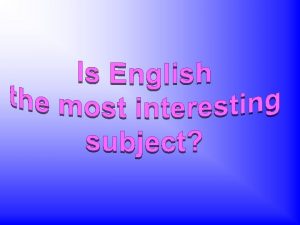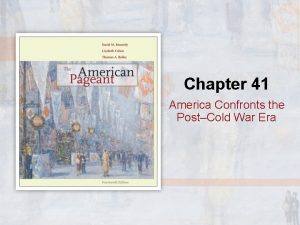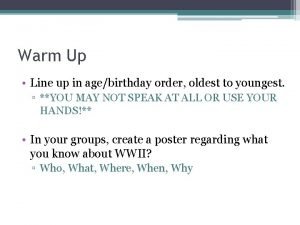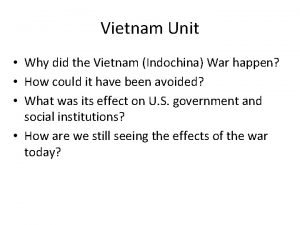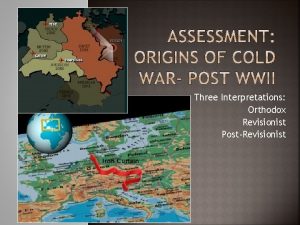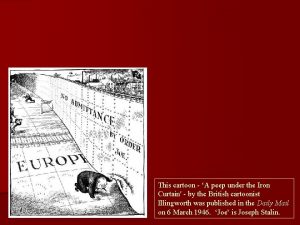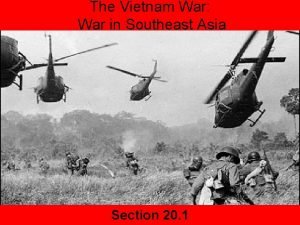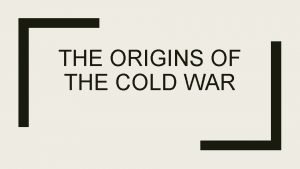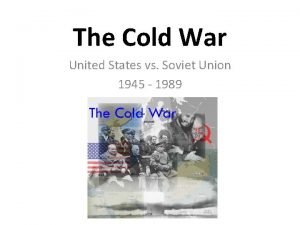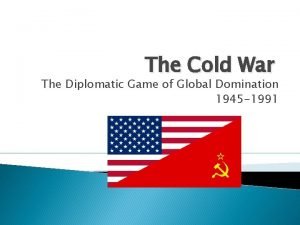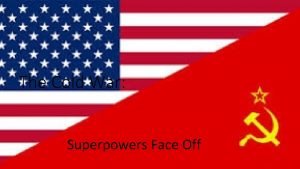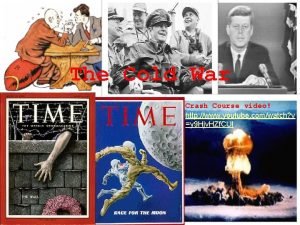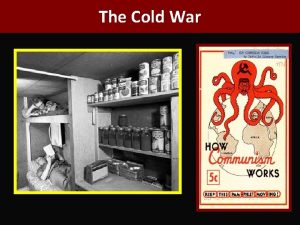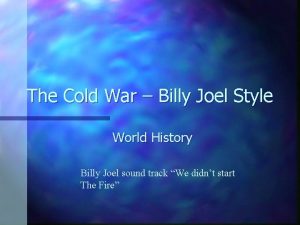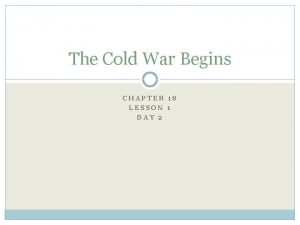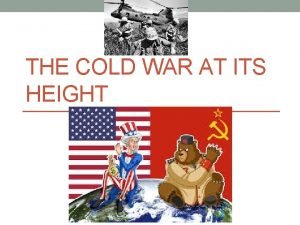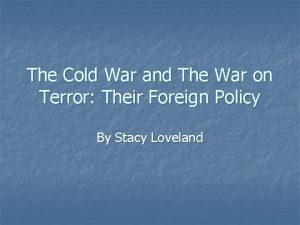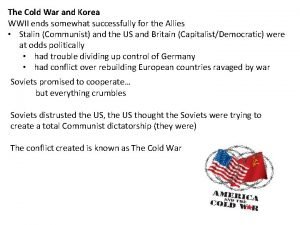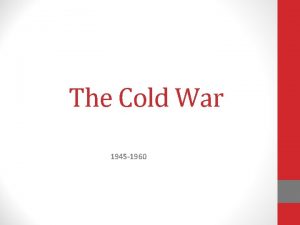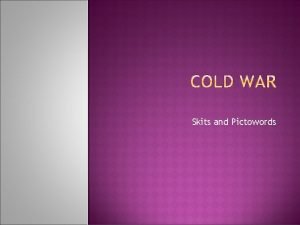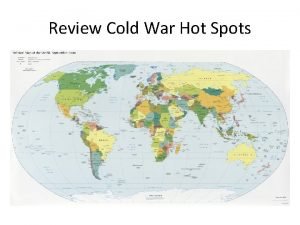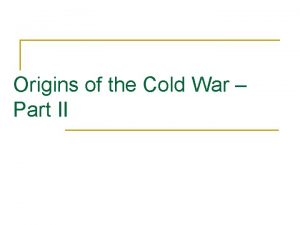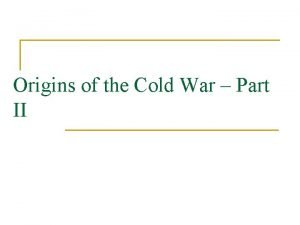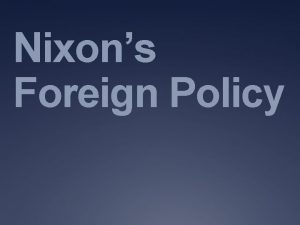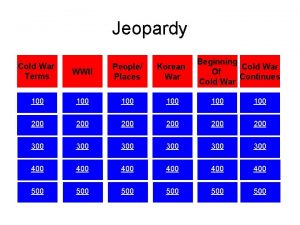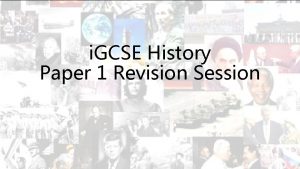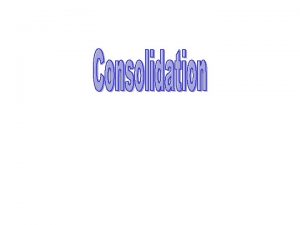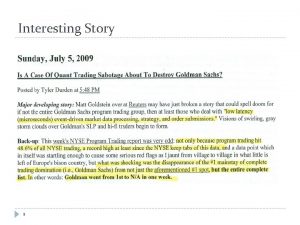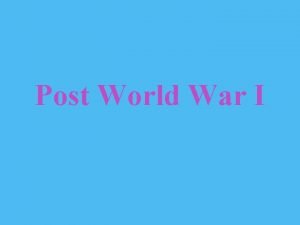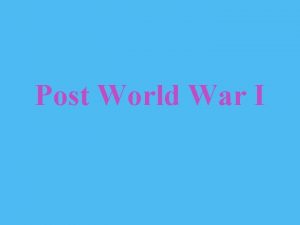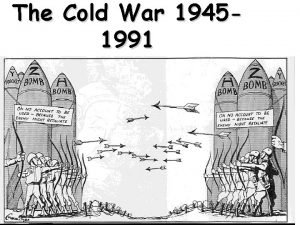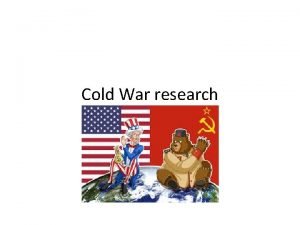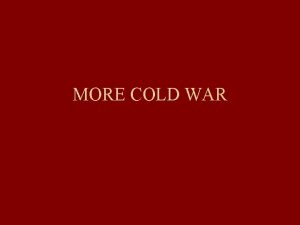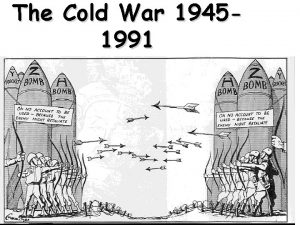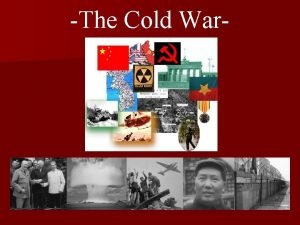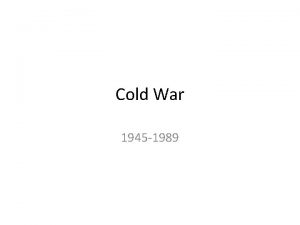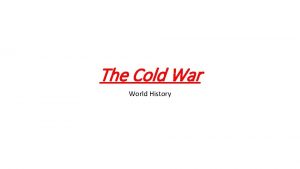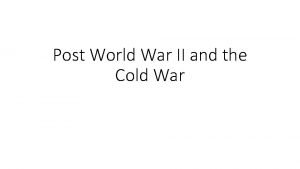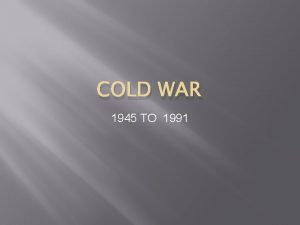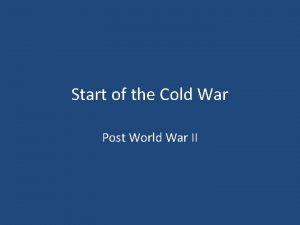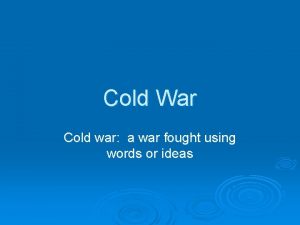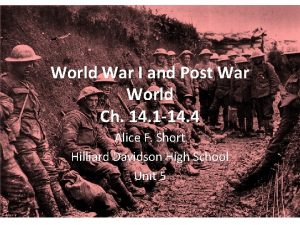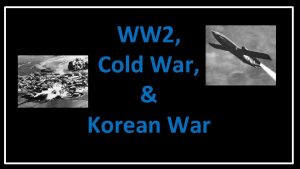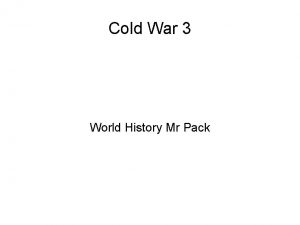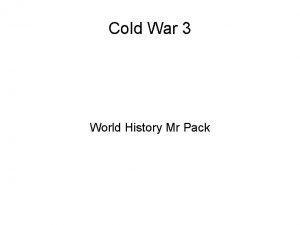POST WORLD WAR II THE COLD WAR INTERESTING




























- Slides: 28

POST WORLD WAR II THE COLD WAR


INTERESTING WWII TIDBITS: • THE YALTA CONFERENCE – Roosevelt and Churchill got a promise from Stalin that free elections would be held in the countries in Eastern Europe that were occupied by the Soviet army • THE NUREMBERG TRIALS – Important Nazi leaders were tried and convicted by an international tribunal for “crimes against humanity” – Revealed German atrocities to the world – Reaffirmed that not just a country, but individuals were accountable for violations of international law

Continued… • Hideki Tojo – was the prime minister of Japan who convinced Emperor Hirohito to attack the U. S. at Pearl Harbor – After being found guilty at his trial for war crimes, he was executed after the war • Albert Einstein – Played a key role in developing the atomic bomb – He had fled Germany after Hitler came to power and came to the U. S. – During the war, he feared Germany was developing atomic weapons

Continued… • The destruction of WWII was unparalleled – As many as 70 million people died – Much of Europe and Asia was in ruins – Germany, Italy, and Japan were occupied and turned into democratic nations – Brought about the end of imperialism in Africa and Asia – Cost more than two trillion dollars

UNITED NATIONS • Replaced the League of Nations • Guaranteed the security of member nations • Fostered good will through equal rights • Encouraged economic, cultural, and humanitarian cooperation

NATO • The North Atlantic Treaty Organization was a military alliance – Formed in April 1949 – Original members: Belgium, Luxembourg, France, the Netherlands, Great Britain, Italy, Denmark, Norway, Portugal, Iceland, the United States, and Canada – Sought security during the Cold War

OTHER ALLIANCES • The Warsaw Pact: Soviet Union, Albania, Bulgaria, Czechoslovakia, East Germany, Hungary, Poland, and Romania • SEATO (Southeast Asia Treaty Organization): U. S. , Great Britain, France, Pakistan, Thailand, the Philippines, Australia, and New Zealand • CENTO (Central Treaty Organization): Turkey, Iraq, Iran, Pakistan, Great Britain, and U. S.

U. S. ACTIONS THE MARSHALL PLAN THE TRUMAN DOCTRINE • Designed to rebuild the • Stated that the U. S. prosperity and stability of would provide money war-torn Europe to countries • Included economic threatened by recovery Communist expansion

NATIONAL POLICIES • Western allies wanted to achieve security by strengthening democracy • Soviets wanted to establish pro-soviet governments in Eastern Europe • The “iron curtain”, a soviet-made barrier that split Europe into communist and noncommunist countries, developed • The U. S. implemented a policy of “containment” or keeping communism within its existing boundaries and prevent further Soviet aggression.

KEY EVENTS OF THE COLD WAR

The Berlin Blockade • The soviets blocked allied supplies from entering Berlin (West Germany) from June 1948 -May 1949 • In 1949, the 3 western zones merged into a new independent state – Federal Republic of Germany (West Germany) • Stalin turned the Soviet zone into the German Democratic Republic (East Germany)

THE BERLIN WALL • In 1955, The Berlin Wall was built to prevent East Germans from escaping through West Berlin

Communist Revolution in China • Chinese leader, Chiang Kai-Shek, had united China in 1928 • After WWII, Mao Zedong led communist forces against the nationalist government • He was helped by the Soviets • Mao won the support of the peasants through land reform programs and finally drove out Chiang • Nationalists retreated to the island of Taiwan and vowed to return to mainland China

CHINA UNDER MAO • The Great Leap Forward – 1956, he introduced a Five-Year Plan to turn China into an industrial power. Used large population to build dams, roads, and factories. Poor planning and high costs caused economic disaster (30 -50 million died) • Cultural Revolution – laid out his blueprint in his “Little Red Book” to create the ideal Communist society. Created Red Guards to revitalize society, but they created a lot of violence, instead (as many as 1 million died)

Korean War • A fight to halt the spread of communism in Korea • A civil war attempting to reunite Korea, fought by opposing regimes (the North backed by Soviet forces and the South backed by U. S. forces) • June 25, 1950 to July 27, 1953

Bay of Pigs • Unsuccessful attempt by American-backed Cuban exiles to overthrow Fidel Castro • April 1961 (three months after John F. Kennedy took office as president) • Further strained U. S. – Cuban relations

The Cuban Missile Crisis • The Soviets placed nuclear missiles in Cuba as a threat to the U. S. and to offset U. S. missiles placed in Turkey. • 1962

Vietnam War • A fight to halt the spread of communism in Viet Nam by nationalist leader, Ho Chi Minh • North Vietnam (Viet Cong) backed by communist allies were opposed by the South Vietnamese rebels backed by U. S. forces • U. S. military advisors first arrived in 1950 • U. S. involvement escalated in the early 1960 s and combat units were deployed beginning in 1965 • The Tet Offensive in 1968 demonstrated the strength of the Viet Cong • A peace treaty was signed in 1973 by all parties and the U. S. withdrew its troops • 1975 Saigon fell to North Vietnam

Cambodia • American withdrawal from Vietnam led to the collapse of the government in Cambodia • Khmer Rouge (Cambodian Communists) seized control • Pol Pot (leader of Khmer Rouge) carried out the genocide of city dwellers and other opponents • As many as four million died between 1975 and 1978

CHANGE IN THE SOVIET UNION • Stalin died March 5, 1953 leaving power to a group of leaders • Nikita Krushchev emerged as the chief Soviet policy maker and began a process of de-Stalinization. He implemented economic reforms and loosened government controls on literary works. • When Krushchev was removed from office in 1964, Leonid Brezhnev emerged as the dominant leader in the 1970 s. He allowed soviets more access to Western culture. • A long period of stagnation (failure to advance) began: there was little incentive to work, farms failed to produce enough food, poor quality goods, and low living standards – alcoholism, corruption

Problems for the Soviets • Afghanistan – Long, drawn-out war against local nationals – Tied up large numbers of forces and soldier deaths – USSR’s “Vietnam”

The Gorbachev Years (1985 -1991) • In March 1985, communist party leaders chose Mikhail Gorbachev to lead the Soviet Union. – He implemented economical and political reforms known as perestroika – Glasnost: greater openness of Soviet society, released dissidents, eased restrictions on Jews and others, began elections – New Directions in foreign policy: withdrew troops from Afghanistan, entered into talks with President Reagan, permitted democratic elections in Eastern Europe

Detente • A relaxation of tensions between the U. S. and Soviets • 1972

FALL OF THE IRON CURTAIN IN EASTERN EUROPE • Poland led the way in the demand for change – Pope John Paul II (1 st non-Italian Pope in 400 years) inspired other Poles to challenge the status quo – Lech Walesa organized an independent trade union named Solidarity and led a strike of workers which spread throughout Poland – Poland became the first Eastern European nation to elect a non-Communist government

Continued… • This promoted a lifting of the “Iron Curtain” in other places (East Germany, Czechoslovakia, etc. ) • November 1989 – The Berlin Wall fell • Free elections were held throughout Eastern Europe which brought non. Communist governments to power

Changes, continued • Gorbachev resigned on December 15, 1991, and turned over responsibility to Boris Yeltsin who became the new president of Russia (the Soviet Union had ceased to exist when a number of Soviet republics voted for independence). • Yeltsin resigned at the end of 1999 and was replaced by Vladimir Putin who was elected president in 2000. The economy greatly improved due to his reforms.

CHANGES TO GERMANY AND CHINA • Germany was reunited – Helmut Kohl (West German leader) helped negotiate the reunification • China introduced free enterprise gradually without abandoning their monopoly of political power – Deng Xiaoping took over after Mao’s death – His goal was to modernize China
 Interesting more interesting the most interesting
Interesting more interesting the most interesting Lesson 1 the cold war begins
Lesson 1 the cold war begins America confronts the post-cold war era
America confronts the post-cold war era Proxy wars
Proxy wars Acrostic poem
Acrostic poem Napalm vietnam war
Napalm vietnam war Postrevisionist
Postrevisionist Iron curtain cartoon explanation
Iron curtain cartoon explanation Operation rolling thunder cold war
Operation rolling thunder cold war Cause of the cold war
Cause of the cold war Who fought in the cold war
Who fought in the cold war U2
U2 Cold war superpowers
Cold war superpowers Cold war crash course
Cold war crash course What were the characteristics of the cold war?
What were the characteristics of the cold war? Mafia hula hoops 1959
Mafia hula hoops 1959 Lesson quiz 18-1 the cold war
Lesson quiz 18-1 the cold war The cold war at its height
The cold war at its height Cold war who was involved
Cold war who was involved Cold war countries
Cold war countries Two sides of the cold war
Two sides of the cold war Causes and effects of the korean war
Causes and effects of the korean war Totalitarianism pictoword
Totalitarianism pictoword Cold war hot spots
Cold war hot spots Origins of the cold war
Origins of the cold war Origins of the cold war
Origins of the cold war Vietnamization definition
Vietnamization definition Cold war jeopardy
Cold war jeopardy Operation rolling thunder cold war
Operation rolling thunder cold war
